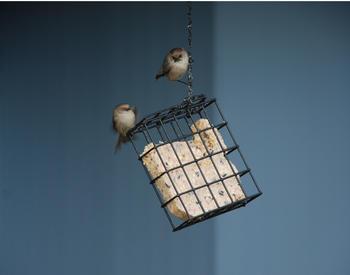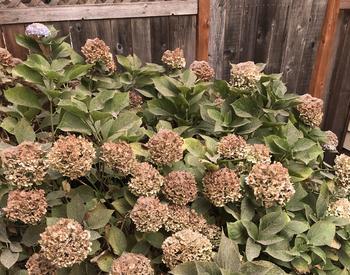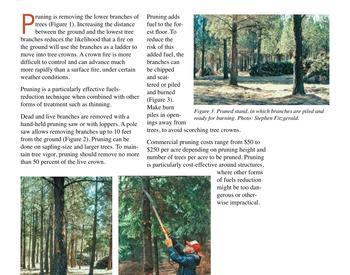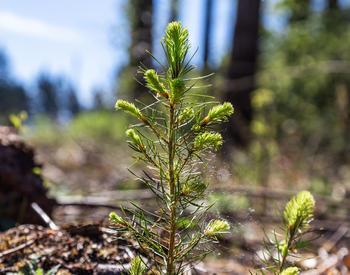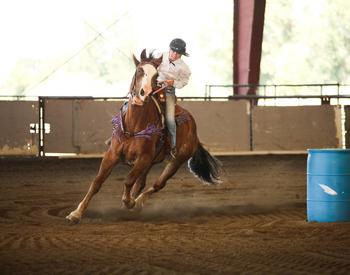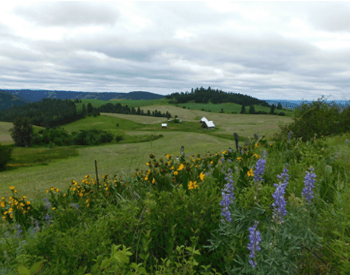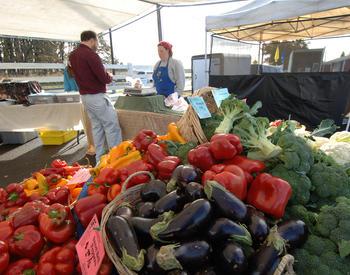Transcript
From the Oregon State University's Extension service you are listening to In The Woods with the Forestry and Natural Resources Program. This podcast aims to share the voices of researchers, land managers, and members of the public interested in telling the story of how woodlands provide more than just trees they provide interconnectedness that is essential to your daily life. Stick around to discover a new topic related to forests on each episode.
Lauren: Welcome back to another episode of In The Woods. I'm your host Lauren Grand, Assistant Professor of practice and Extension Agent in Oregon State University's College of Forestry. Today's topic is what's in a woodland? I'm really excited to have joining me today Daniel Stark Assistant Professor of practice and Extension Agent serving Clatsop, Tillamook, and Lincoln counties. Dan has a Masters of Science with a focus in wildland fire and forest health from UC Berkeley. Previous to his work at OSU Dan spent six years working as an outreach coordinator for the California oak mortality task force and University of California cooperative Extension service. Welcome Dan!
Dan: Thanks Lauren
Lauren: Dan, I'm so excited to have you on the podcast as one of our first guests mostly because I'm lucky enough to know you as a good friend outside of work.
Dan: I know it's so great that we are co-workers and we are also friends i really like that
Lauren: Because I have the pleasure of knowing you as a really good friend I also happen to know that you have a special interest in conflict resolution around contentious forestry related issues. So, of course I'm going to start with a contentious forestry related issue just to catch you off guard. What's the deal with all the terms for forests? How come some people call it a woodland, some people call it a forest, and some people call it a timberland? What's the difference?
Dan: I mean which term do we use to describe our forests here? So, we could use forest, we could choose woodland, timberland, you know are there difference between those, they all mean the same thing. They all mean forest. Um so, I was preparing for this i was looking up what woodland meant and I wanted to study the etymology of it and it's actually a term that's old English um wudulond I think is how you pronounce it back to the 14th century um so it's just kind of cool how we have these forestry terms that have just stuck around with us for literary centuries and they're still used today.
Lauren: Yeah you got it Dan it's not really a contentious forestry related issue I was just yanking your chain there. I just wanted all of our listeners to know that throughout the podcast we're probably going to refer to forest as woodlands or timberlands or interchange them here and there and we want everyone to know that we're talking about the same thing we're talking about forests.
and today we're going to be talking about what's in a woodland and Dan is going to help guide us through that. When we talk about woodlands and forests the first thing that usually comes to people's minds is trees. Dan what can you tell me about the trees that we find in woodlands?
Dan: Yeah so I mean they are trees in a woodland, right? So, they are the obvious structure. It's what we see, right? and um forests and woodlands are actually defined by you know the presence of trees so I mean it makes sense that we think a lot about trees. Um trees vary by location and by sight so depending on the like particular ecology of a particular site um you're going to get a particular tree that grows there. um They could be a single species, they could be mixed species. Going back to ecology I also think about you know how disturbance really plays a role in um you know um and what kind of tree grows on a site. So, if you are in an area of Oregon, let's say that you know gets or is prone to a lot of wildfire it's really dry and stuff you're going to get a particular type of tree that grows there that can do well in that type of environment like a ponderosa pine for example. Um out here on the coast we don't have fire as a major disturbance agent um it's very infrequent here on the coast um so we get trees that are more adapted to you know wet conditions and and these foggy conditions here so we get things like Sitka spruce so um the the location of where you are and the ecology on the site the type of disturbance that happens those all work together to produce this forest that we see and that we live in and work in.
Lauren: That's awesome um so you mentioned that you have Sitka spruce there on the north coast what other type of tree species are pretty common over there?
Dan: yeah well we have um oh there's such pretty trees up here so we have um Sitka spruce and um I have a lot right outside of my window here working from home and I just love them and they have this great lichen hanging from them right here on the coast and lots of fresh air here so we get lots of like and hanging from these trees we have Sitka spruce um we have a lot of the hardwoods that you might see throughout in other places in Oregon too like bigleaf maple we have red alder and we also have some Douglas-fir around so um a lot of great beautiful hardwoods and we have some conifers there too. We also have western hemlock just some really beautiful trees that just thrive and do really well up here on the north coast.
Lauren: I'm based in Eugene and we have a similar, similar set of a set of trees um maybe we have a little bit more um cedars types of cedars a western redcedar as well as grand fir which I personally like you know because of my name.
right we have redcedar I'm here too
and then um because we're sort of in the confluence of where it starts to get really dry we also have incense-cedar, um as we're at the northern part of incense-cedars range and then we also have some oak lands, so here in Eugene we have Oregon white oak and we're starting at the confluence of where California black oak begins as well. So kind of um fun to have different different woodlands around no matter where you are. And then our friends over on the east side um I'm jealous they have larch trees, do you like larch trees?
Dan: I do and being a California boy originally i don't have a lot of, you know exposure to larch, so when I see them I'm always like oh my gosh! it's a larch! how cool.
Lauren: I know it's really exciting. Something interesting about Oregon is that um actually on the coast uh somebody planted a stand of larch trees in the shape of a smiley face
Dan: oh nice
Lauren: and you can only see it in the fall when the trees start to turn yellow to lose their leaves and there's a yellow smiley face in the side of the hill
Dan: Wow
Lauren: So, I don't know exactly where it is it's um mid-coast I think but um you all should look it up and drive by one day.
Dan: I will that's really cool and I just have to say I really miss the oak woodlands I mean they are just some of the greatest trees and some of the most long-lived trees and they just they're so beautiful and they have their own ecology and you know they just their own diversity with some of the most diverse forests that we have are our oak woodlands, just beautiful. I miss the oaks.
Lauren: You have to come visit me more then
Dan: I will
Lauren: So we talked a lot about trees and trees are obviously one of the most exciting and beautiful parts of a woodland, but there's many other parts so what else do we see in woodlands Dan?
Dan: Well, my background is in forest health, so one thing that always stands out for me are the what we call pests. I mean they are ecological components of a forest like in a bark beetle or other forest insects and um crucial to the functions of the forest, but they become pests right so they they cause some kind of economic injury so I pay attention to things like bark beetles and and forest pathogens and um pathogenic fungi and you know that can cause some kind of forest health issues to your forest, but there are also beneficial insects and um and beneficial fungi as well so I think of mycorrhizal fungi for example so not all not all fungi and not all insects and forests are bad, they're important components of a woodland. There are also animals, our wildlife, of course water right in our watersheds a lot of our water comes, most of our water comes through our our watersheds here that we manage here, um there are soils right you can't have a forest without soil you can't grow plants without soil or your substrate um there are of course can't leave out humans um we often like to think of humans as separate and um apart from from our woodlands and our nature but we are very much um a part of our woodlands and have been for forever.
Lauren: That was a good list of things that are in a woodland. Sometimes it's hard to narrow down all the other things that that are going on in a woodland besides the trees, but I think you did a good job of hitting most of them. So Dan, can you talk to us a little bit about why we need to look beyond the trees when we think about a woodland? What's so important about how all these other aspects are involved with the trees?
Dan: Yeah well it's about this interconnectedness right? Between all of the everything that we listed here and then beyond right so um i talked about soil so a tree can't just grow on its own it depends on so many things that it's connected to in the forest so looking at the soil right so it has to be the right type of soil there has to be the right type of micronutrients in that soil to support the growth of that tree over its over its over its lifetime over its over its lifespan um mycorrhizal fungi we talked about the fungi present there that are helped the tree grow and and um so just that connectedness just between the soil and the tree alone then we look at the bigger picture right i mean look at water and abundance of water um or lack of water right if there's um if you have a lack of precipitation or there's too much precipitation that there's a connective connectedness there um with the atmosphere right and everything in a forest so again my background is in forest health um I think about those forest insects that can cause damage and you know on the surface I mean yeah they do cause some kind of economic damage but they really are filling out an economic um or sorry not an economic function an ecological function and they have an ecological role to play and they too are not separate in this equation so there are birds that like to feed on those insects that are feeding on the trees so it really is just about that connectedness trees are there and they're wonderful but they depend on everything else in that system just to survive and to get through their long life and it's a struggle.
Lauren: It's a struggle especially when you live for 250 to a thousand years you know there's lots of stuff you have to deal with.
Dan: yeah constantly just you know i mean just think of everything that could just go wrong for a tree with with pests and just with droughts and too much rain i mean it's a hard life for a tree and they really are durable creatures
Lauren: They are yeah, I especially liked your example about the pests and then the birds eating the pests and even if those pests kill those trees you know all my biology, wildlife biology friends are always saying more dead wood, right? so that's why those insects kill those trees, it creates homes for more of those wildlife that you see in the forest.
Dan: That's right and thinking about the ecological role of what we call pests, I mean they could be beneficial to the the population of trees as a whole because unless they're an outbreak condition meaning they're you know this is what we hear a lot about and we um hear about parts of british Columbia or the Rockies were just you know thousands of hectares are taken out by the mountain pine beetle or other beetles when they're not in that outbreak stage they perform an ecological role so they can actually um help in the natural selection of that overall forest and those trees by weeding out the the more weak individuals that aren't quite doing so well on a site so even though it might be you know look horrible that they're killing some trees you know that that dead tree like you mentioned could provide habitat for a whole host of different wildlife species um those nutrients get broken down and get returned to the soil and you know feed other trees and um so you know there is a place for everything there
Lauren: That's a good point sometimes we see dead trees and we get really upset about them, but it's always important to remember that they have value as well.
Dan: That's right
Lauren: So, we talked a little bit about in your list that humans are part of a woodland can you talk a little bit more about humans or our, humans like we're not humans I'm talking about humans like we're not humans, how about our role as forest managers or our role as humans in the woodland?
Dan: yeah yeah so um humans are animals and we are a part of the forest just like other animals are and um I you know this is all we could talk forever about this one there's some really neat kind of um just how we got to this point where we think of forests and nature in general as separate and when in fact it's been we've humans have been a part of forest forever right um and um just one need only look at our indigenous communities who have been around for for thousands and thousands of years um being a part of forests and and um we are not separate from forests so I mean you and I work in forests we also in Oregon we live in forests right I mean this is one of the best states here you know um we have a lot of forests so chances are um if you're especially if you're in the more western part of the state you're gonna be in some forests um and of course other parts of the state too um so we we live in the forest we work in forests we depend on forests right for our food and for products and for air and um wildlife everything we are a part of forests they're a part of us.
Lauren: You're absolutely right Dan we are part of the forest and we as extension agents work a lot with people who own forestland and are actually managing some of these smaller properties that they live on and I'm always interested in letting the public know who doesn't manage land how these people steward their land so how does it that they the people who own land actually make decisions about what they want to do when they're managing their woodland or forest?
Dan: Yeah well I'm thinking a lot about this right now um where teaching a class coming up on basic woodland management so you know this is really where we get into the nuts and bolts of this here and really starting with the basics and what we we start off with is really just you know finding out what's on your assessing what's on your property first of all like what what do you have growing there right and then coming up with some goals right you need to what do you want to do with your property you know this is your woodland this is you know no one else is going to tell you what to do um so think about what what you like and what what you'd like to have for your property are you going to be is your goal to just provide a nice sweet spot for you to retire and you're just going to hang out there and um you know just enjoy this the the the beauty of your trees and you know are you gonna manage for wildlife are you you know are you really into encouraging um a particular birds let's say to you to your um to your property um or you might you know really like deer coming in um dear brows and a lot of people don't think of them deer in elk's pests but you know that might be something you enjoy there might be a part of your your property where you can really enhance that habitat you might want to have some grow some timber right you might want to um manage your forest so you can um cut down some trees and um provide a little income for you and your family and down the road too for for for your family down the road um and leave that legacy for your family so really coming up with that objective you might have several objectives right depending on how big your property is um you most likely aren't going to just have a single objective so thinking about what those goals are for a particular parts of your property or for your whole property and then really backing that up with a plan so developing a plan how do I meet these goals? What is it I need to do? Who do I need to contact? What resources are available to help me? and How do I meet those objectives over time? um so and your plan is going to change too so what plan you might start with today will probably change down the road right we don't know what's going to happen in the future we can predict as best as possible but you know things around us change and then our ideas and the way we we live our life change too so um that's okay uh build some flexibility into your goals and your management objectives this is a long term strategy you're not just planting a garden for to harvest at the end of the season right this is something that's going to be with you for a long long time.
Lauren: Yeah I mentioned you mentioned um getting some help and so do you have who are the people that we can talk to to get some help about coming up with what these management goals are and maybe some some plan ideas for reaching those goals?
Dan: Gosh Lauren I don't know if you find out please let me know. I've been looking everywhere. No, I'm just kidding Oregon State um Forestry and Natural Resource Extension is your one-stop shop for a lot of those resources so check out what we have online and um give us a call too call up your call up your um your county Extension forester um and they're here to help so I mean we work hard to provide content and education for folks so um apart from your Extension office I mean reach out to your local ODF office we have stewardship foresters that are here to help woodland owners and to you know help them with their management plans um I know a lot of small woodland owners who hire consulting foresters so um this works really well um for people who you know these are this is the job of a forester right you might know that not know the first thing about like what what you what you need to do in your forest and the this is the role of of of a consulting forester is to help you understand um what's on your property and how to manage it for you and to help you find the best solutions for you. Um oh my gosh, there are just so many resources in Oregon like I mentioned I'm from California and we have had a lot of resources down there too available for small woodland owners but my goodness up here there's just so much and as you know someone new to Oregon I've been using a lot of these resources myself just to brush up on what's happening here so one of my go-to's is the Oregon Forest Resource Institute um and they just have all kinds of educational content for people and to help them understand forest management practices to help understand wildlife and regulations and um it really is a good spot just to kind of clear up and you know if you're if you're not sure about something you'll get the answers on that site so there's just so much information available for people here in Oregon and it's it's really is um an exhaustive list I feel um so reach out and your Extension forester can help you navigate through all of those resources too if you're having problems finding where to where to look for the right things.
Lauren: yeah good uh good plug for us, thanks Dan
we can help connect you to there's many more people on that list and so we're happy you to all those people you mentioned earlier that people have goals and objectives and then you come up with a plan and so I'm just curious you know the landowners that are coming up with this plan or the consulting foresters that they hire or the Extension agents that give them suggestions on things that they might be able to do to reach those goals you know how do those people know what is available or what what management activities are available for people to be able to steward their land effectively to reach the goals that they're interested in reaching?
Dan: I have two words forest science there is a lot of research out there available to help us make decisions about um the management practices that that we choose dependent on our our chosen goals right and our objectives for our property so a lot of those a lot of that research is around this applied ecological techniques right so um let's put that into plainer words so um we could mimic the natural processes that happen in a forest and and and based on management practices on some of those um natural processes for example let's say um think about root disease so root disease um it's you know it's caused by fungi fungus and um it can spread from root to root and you get these these disease centers so some of you might might have heard of of um you know like a um something like armillaria or or heterobasidion, annosum root rot or some other kind of of root pathogen that causes this mortality center in your forest um so you get what ends up happening is you have a patch there so that patch gets reseeded often with with either by natural regeneration or you can plant in those gaps there to recreate or you know to have a different uh a new forest in that opening there so there was an opening created by that disease and and there's that's a spot for new seedlings to grow so you can create that and mimic that process these two on your own property let's you know what we talked about managing for wildlife you know there might be um a part of your property where you want to have a particular type of trees growing that will you know encourage a particular type of bird species for example so that group process you can plant in those groups and kind of mimic those natural processes so there are lots of examples of this in in science and through research. Um and one of these natural processes is fire so think about how fire can impact your landscape and your forest so um i think about um in more of our drier type forests where we have historically more low intense fires um meaning that you know they um they're not going to be killing a lot of trees they typically stay close to the ground and serve this function and that they happen more frequently historically too so that comes in in so that will naturally thin out what we call those ladder fuels so trees and and other shrubs that that form a ladder up into the canopy of other trees so fire can those low intensity fires in particular and we can also you know use prescribed fire to recreate that as a management process as a management technique to recreate that structure that fire has by thinning out those those ladder fuels so fire isn't a prescribed burning isn't always an option in a lot of places due to air quality concerns and a lot of regulations or you know it's hard we don't have big windows for prescribed burning either so we can have management techniques that mimic what those low intensity fires can do by thinning from below for example um um coming in and and cutting down those those ladder fuels and um those can be those fuels can be um removed from the forest they don't have any kind of value timber wise or anything like that but they could be either put in a slash pile or they could be you know sent off and be used as biomass so um these what it all is to say is that we have a science that shows us that we can manage forests and that's based on this applied ecological techniques that that um that we've been setting.
Lauren: Forest science is really great to have to be able to help guide people through what decisions that they make when they're managing forests and it's always changing and evolving which is also fun and exciting and we're learning new techniques all the time. Thank you for sharing some of those really good examples. Thank you so much for joining us today Dan to talk about what's in a woodland um as we start to wrap up here i have a few questions i want to ask you that we plan to ask all of our guests the first one is, What's your favorite tree?
Dan: Okay my favorite tree, it's hard to choose just one but I would have to say it's ponderosa pine and Jeffrey pine that's two um there was a period of time where they thought they were the same tree because they're so similar in in appearance and and everything else so um they actually are very different trees um I love ponderosa pine and jeffrey pine for different reasons so um I mean both are just really suited for adapting uh to dry climate and um i just think that they grow beautifully and just that that typical conifer shape and I love pines in general I just love the scent and what I really like about ponderosa and Jeffrey and ponderosa in particular is just that big puzzle-like piece bark that they can get when they get super old and just those really deep ridged furrows in the bark and they're just like there's big platelets but they're just so fantastic and of course that's a fire adaptation um and it's just fantastic their needles are adapted to fire they grow long they're skinny so they fall on the ground and they can create little piles or they do create little piles of of um needles on the ground and those help ignite fires right and so that that's all an adap adaptation to a frequent fire regime they're just super cool um jeffrey pines are just as cool as as ponderosa they tend to grow on more drier sites um and they sometimes can smell like butterscotch and I just I love that smell and it's just they're just such beautiful trees and they just are survivors and I just love them for that reason.
Lauren: yeah they're gorgeous have you ever um tried to put the puzzle pieces back on the bark of the ponderosa pine.
Dan: I have not, I'm usually chopping them off with my axe for insects I'm not putting them back on
Lauren: Oh you forest health guys always have your axe with you
yeah well i've I've spent many a lunch time um underneath the ponderosa pine eating a sandwich and trying to sometimes re-puzzle the trees back together and it makes the time go by when you're out in the woods alone
Dan: That sounds delightful
Lauren: so our second question is what's the most interesting thing that you bring with you in the field whether it be in your cruiser vest or your field kit?
Dan: All right well I just gave one of them away I like to bring an axe with me and have a big blue handled axe that I got from um one of my forest ecology professors back in college and you had them too Lauren professor Joe Mcbride emeritus professor now passed on his axe to me and I carry that with me with pride and um but I use that to chop into trees when they're dead and just to look for um forest health issues and pest issues um so but I mean that's not too weird I think one of the things that I just really treasured to this day and I'm gonna send you a picture of it maybe one day you'll be in the field with me I have an old school old-timey tupperware container has three compartments one big compartment for my sandwich and then there are two other little compartments one for some kind of potato chip or tortilla chips and then there's even a little pocket or a little space for some dessert or maybe sometimes I like to add a pickle it all depends but it stays nicely separated and my mom sent that off to me or sent that with me when i went off to college the first time um way back in the early 90's so um that that piece of tupperware was probably old at that point and it's still with me today and it's cracked and um I'm gonna be duct taping it here I just love it I put it right in the back of my vest and um it's a little bulky but hey it works and I and I love it so yeah
Lauren: You know Den what they say about fashion is what goes around comes around and you know yeah
i've bought myself a tupperware with the same compartments they're so handy I like them very much mine's silicone though so you need to be up with the times
Dan: That's true yeah yeah I don't think I want to bring back more plastics but
Lauren: I think the duct tape will keep its character
Dan: I hope so
Lauren: Okay so our last question is What resources would you recommend to our listeners if they're interested in doing a deeper dive and learning more about how forests grow on their own?
Dan: Well I think that just the best place to find all this information is really the Forestry and Natural Resources Extension site it's a good starting point um for sure a lot of great resources there available at your fingertips and they're all categorized nicely so have a look at that so whether you're interested in management um if you're interested in you know um fire um prevention or um um defensible space or any of that check out the FNR Extension website there's all kinds of information there for you um one of the other sites that i really love and just really helps me out um is knowyourforest.org and that's the website put out by Oregon Forest Resources Institute and like I mentioned previously just anything any type of educational content that you need to help understand forest management practices to understand the forest practices rules in Oregon to understand issues of wildlife and water use and management it's it's everything is there so lots of information and be sure to reach out to your Extension forester um who again can help you navigate through all of these and can help you narrow down some of those those resources that sometimes might seem a little overwhelming
Lauren: Those are some great resources and yes definitely and we'll be sure to put them in our show notes for people to be able to find more easily well that concludes this month's episode of In The Woods. Thank you so much Dan for joining us it was really fun being able to chat with you.
Dan: you're welcome Lauren it was a pleasure to be here it was fun to chat with you too
Lauren: Thank you all for listening today and stay tuned for next month's episode with Dr John Bailey from Oregon State University's College of Forestry on How Forest Grow.
Thanks so much for listening! Show notes with links mentioned on each episode are available on our website
blogs.oregonstate.edu/inthewoodspodcast. We'd love to hear from you. Visit the tell us what you think tab on our website to leave us a comment, suggest a guest or topic, or ask a question that can be featured in a future episode and also give us your feedback by filling out our survey. In the woods is produced by Lauren Grand, Carrie Berger, Jacob Putney, Stephen Fitzgerald, and Jason O'brien who are all members of the Oregon State University Forestry and Natural Resources Extension team. This podcast is made possible by funding from the Oregon Forest Resources Institute. Music for In The Woods Podcast was composed by Jeffrey Hino and graphic design was created by Christina Friehauf. We hope you enjoyed the episode and we can't wait to talk to you next month. Until then what's in your woods?
Lauren Grand talks to Daniel Stark about what makes up the parts of a woodland and a bit about land stewardship.
